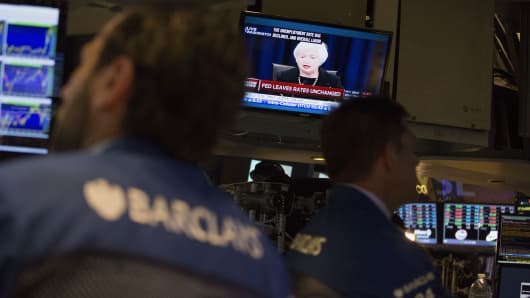Global economic weakness and recent market volatility will prompt theFederal Reserve to delay, but not cancel, rate hikes this year, according to the most recent CNBC Fed Survey.
An overwhelming 88 percent of survey respondents say the Fed’s next move will be to hike interest rates, but they’ve put off that hike until May, a month later than the survey conducted in December. Just 13 percent believe the Fed’s next move will be to either cut rates or launch another quantitative easing program.
“Financial turmoil and the stock market swoon are overdone, especially with additional policy stimulus to come from outside the U.S.,” said one of the respondents, Allen Sinai, chief global economist of Decision Economics.
Many of the 40 respondents, who include economists, fund managers and analysts, agreed the Fed should not be reacting to the recent market volatility. Just 15 percent say the recent rate hike was a mistake; 80 percent said it was “the right move.” While 100 percent of respondents say the Fed won’t hike at its January two-day meeting, which begins Tuesday, some say hiking will be the right move again as soon as March. The survey was conducted Thursday and Friday.
“We see nothing fundamental in market dips and expect the Fed to look through this in March,” said John Ryding, chief economist of RDQ.
Still, 56 percent say the recent market volatility will delay future rate hikes. And while the Federal Open Market Committee has suggested four rate hikes this year, respondents to the CNBC Fed Survey see an average of roughly just two. In fact, 66 percent in the survey predict zero to two hikes. Respondents see the funds rate ending the year at just 0.88 percent, compared with the Fed’s 1.4 percent projection.
The aggressive forecast from the Fed has sparked some criticism. “The Fed is dogmatic and not at all keeping its eye on the bouncing ball of growth and of changing fortunes,” said Robert Brusca, chief economist of FAO Economics.
As to what’s behind the recent sell-off, Wall Street mostly blames it on the oil price decline. Eighty-four percent of respondents said it was a major influence behind the market decline. Chinese economic weakness and the global slowdown were the next biggest factors. But the Fed rate hike and the FOMC forecast for four rate hikes this year were seen as a main driver of the market downdraft by just around a third of the group.
Despite the recent sell-off, Wall Street expects stocks to rebound in 2016 and into 2017. The S&P 500 is seen rising to 2,035 this year and 2,158 next year from the current S&P level of 1,877. But the outlook for the 10-Year Treasury yield hit a new low with a forecast of just 2.51 percent by the end of 2016, down from the prior forecast of 2.67 percent. The 10-year yield closed Monday at 2.01 percent.
And 2016 began with the most downbeat outlook on growth in three years. Gross domestic product is seen growing just 2.17 percent this year. In each of the last two years, January forecasts in the survey for the year averaged closer to 3 percent.
The inflation outlook has also been revised lower, with an average year-end CPI forecast of just 1.5 percent, and oil prices seen lowering inflation by 40 basis points. The probability of a U.S.recession stands at 24.1 percent, among the higher readings from the survey. Previous readings that were higher, however, did not result in recessions.
[“source -cncb”]






